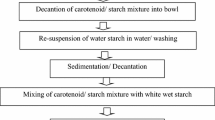Abstract
Rice vermicelli is a main food consumed in China and Southeast Asia. Quality of rice vermicelli varies with rice cultivars. Parameters including amylose content, amylopectin distribution, thermal and pasting characteristics, gel texture and starch granules of three rice cultivars “Zhongjiazao 17”, “Xiangzaoxian 24” and “Thai Jasmine Rice”, were studied for their impacts on vermicelli quality. Results showed significant differences for the measurements of the quality traits and indicated that a favorable quality of vermicelli was not determined by any single factor instead of a combination of multi-parameters. A vermicelli with a favorable quality could be produced from a rice variety with a high apparent amylose content (>25%), a protein content of 11%, an intermediate gelatinization temperature and gel consistency, and a gel hardness (~3 N for a Rapid Viscosity Analyzer pasting) and moderate retrogradation capacity (a setback viscosity of 30–100 RVU).



Similar content being viewed by others
References
Association of Official Analytical Chemists (AOAC) (1999) Official methods of analysis, 6th edn. AOAC, MD
Ding WP, Wang YH, Xia WS (2004) Determination on choosing standard of raw material in manufacturing rice noodle. Food Technol 10:24–26 (In Chinese, with English summary)
Fisher DK, Thompson DB (1997) Retrogradation of maize starch after thermal treatment within and above the gelatinization temperature range. Cereal Chem 74:344–351
Han HM, Cho JH, Koh BK (2011) Processing properties of Korean rice varieties in relation to rice noodle quality. Food Sci Biotechnol 20(5):1277–1282
Hanashiro I, Abe J, Hizukuri S (1996) A periodic distribution of the chain length of amylopectin as revealed by high-performance anion exchange chromatography. Carbohyd Res 283:151–159
Hormdok R, Noomhorm A (2007) Hydrothermal treatments of rice starch for improvement of rice noodle quality. Food Sci Technol 40(10):1723–1731
Jane J, Chen YY, Lee LF, McPherson AE, Wong KS, Radosavlijevic M, Kasemsuwan T (1999) Effects of amylopectin branch chain length and amylose content on the gelatinization and pasting properties of starch. Cereal Chem 76:629–637
Kohlwey DE, Kendall JH, Mohindra RB (1995) Using the physical properties of rice as a guide to formulation. Cereal Food World 40:728–732
Li CF, Luh BS (1980) Rice snack foods. In: Luh BS (ed) Rice: production and utilization. Avi, Westport, pp 690–711
Luo WB, Lin QL, Huang L, Wu Y, Xiao HX, Wang J (2011) Study on physiochemical and sensory properties of fresh rice noodles produced by different varieties of indica rice. Food Mach 27(3):7–12 (48 In Chinese, with English summary)
Ministry of Agriculture People’s Republic of China. The Standard for the Method of the Rice Quality Determination. NY/T 147-1988
Ministry of Agriculture People’s Republic of China. Determination of amylose content in rice-spectrophotometer method. NY/T 2639-2014
Noda T, Takahata Y, Sato T, Suda I, Morishita T, Ishiguro K, Yamakawa O (1998) Relationships between chain length distribution of amylopectin and gelatinization properties within the same botanical origin for sweet potato and buckwheat. Carbohyd Polym 37:153–158
O’Shea MG, Samuel MS, Konik CM, Morell MK (1998) Fluorophore-assisted carbohydrate electrophoresis(FACE) of oligosaccharides: efficiency of labeling and high-resolution separation. Carbohyd Res 307:1–12
Russell PL (1987) The ageing of gels from starches of different amylose/amylopectin content studied by differential scanning calorimetry. J Cereal Sci 6:147–158
Seguchi M, Hayashi M, Sano Y, Hirano HY (2003) Role of amylose in the maintenance of the configuration of rice starch granules. Starch/Stärke 55:524–528
Shi YC, Seib PA (1992) The structure of four waxy starches related to gelatinization and retrogradation. Carbohyd Res 227:131–145
Singh N, Kaur L, Sandhu KS, Kaur J, Nishinari K (2006) Relationships between physicochemical, morphological, thermal, rheological properties of rice starches. Food Hydrocoll 20:532–542
Singh N, Nakaura Y, Inouchi N, Nishinari Y (2007) Fine structure, thermal and viscoelastic properties of starches separated from Indica rice cultivars. Starch-Starke 2007(59):10–20
Tester RF, Morrison WR (1990) Swelling and gelatinization of cereal starches, II. Waxy rice starches. Cereal Chem 67:558–563
Wani AA, Singh P, Shah MA, Schweiggert-Weisz U, Gul K, Wani IA (2012) Rice starch diversity: effects on structural, morphological, thermal, and physicochemical properties-A review. Compr Rev Food Sci Food Safe 11(5):417–436
Xie LH, He XY, Duan BW, Tang SQ, Luo J, Jiao GA, Shao GN, Wei XJ, Sheng ZH, Hu PS (2015) Optimization of near-infrared reflectance model in measuring gelatinization characteristics of rice flour with a rapid viscosity analyzer-and differential scanning calorimeter(DSC). Cereal Chem 92(5):522–528
Yoenyongbuddhagal S, Noomhorm A (2002) Effect of physicochemical properties of high-amylose Thai rice flours on vermicelli quality. Cereal Chem 13:181–189
Author information
Authors and Affiliations
Corresponding author
Rights and permissions
About this article
Cite this article
Xie, L.H., Tang, S.Q., Luo, J. et al. Physiochemical properties of rice starch for production of vermicelli with premium quality. J Food Sci Technol 54, 3928–3935 (2017). https://doi.org/10.1007/s13197-017-2852-9
Revised:
Accepted:
Published:
Issue Date:
DOI: https://doi.org/10.1007/s13197-017-2852-9




